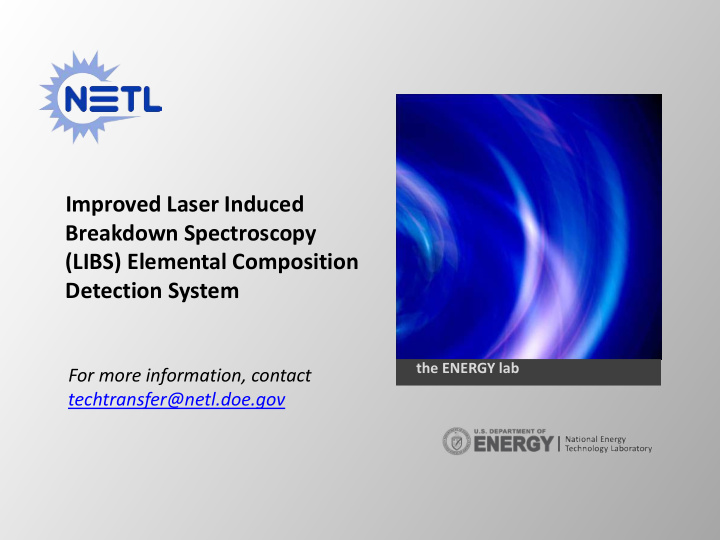



Improved Laser Induced Breakdown Spectroscopy (LIBS) Elemental Composition Detection System the ENERGY lab For more information, contact techtransfer@netl.doe.gov
The Need Sensors are increasingly needed to continuously measure: • Ground water quality – Pollutants in fresh and salt water systems • Air quality, both indoors and outdoors • Gas composition – Natural gas, volcanic gas, landfill gas, shale gas, flue gas • Soil composition These measurements are important to oil and gas exploration companies, landowners, regulatory agencies, and municipalities, and any organization monitoring emissions.
The Problem • Current sampling and analysis is labor intensive and significantly changes the sample by cooling and depressurizing. • Current analysis technology is not amenable for harsh environments.
The Solution A device to measure subsurface gases, liquids, and solids at subsurface conditions, with: • Continuous monitoring of an extreme environment • No sample collection • No sample preparation • Easy to use • Low cost (compared to competitors) • High data quality • The ability to see changes in down hole fluid chemistry before and after injection and/or fracturing
The Technology Atomic identification and concentration • measurements can be made on solids, liquids, and gases at down hole pressure and temperature conditions Technology was developed at NETL as part • of the DOE Sensors and Carbon Storage program Development Stage: • – Proof of concept experimentation completed – Prototype and system design and development underway Two U.S. Nonprovisional Patent • Applications have been filed
The Competition • Gas Chromatography-Mass Spectrometry – Gas phase only, Lab operations and conditions only • Inductively Coupled Plasma-Mass Spectrometry – High degree of sample prep, Lab operations and conditions only • High Pressure Liquid Chromatography – Liquid phase only, Lab operations and conditions only • Cavity Ring Down Spectroscopy – Gas phase only, few ruggedized models available • Portable Raman – Solids only, few ruggedized models available Commercial Opportunity Summary
The Technology Summary • Summary – Down hole contaminant monitoring • Atomic identification and concentration measurements can be made on solids, in liquids and gases at down hole P/T conditions – Market • Regulators, Exploration Companies, Municipalities, Land owners – Development Stage • Laboratory Investigations • Prototype design phase • Funding – Source of funding – DOE as part of the Sensors & Carbon Storage Program • Strength of the team – Optical measurement and laser design experts Dr.s Woodruff and McIntyre USDOE – Geochemistry Expert Dr. Jinesh Jain Commercial Opportunity Summary
Partnership Opportunity This technology is available for licensing and/or further collaborative research from the U.S. Department of Energy’s National Energy Technology Laboratory. For more information, contact techtransfer@netl.doe.gov
Recommend
More recommend